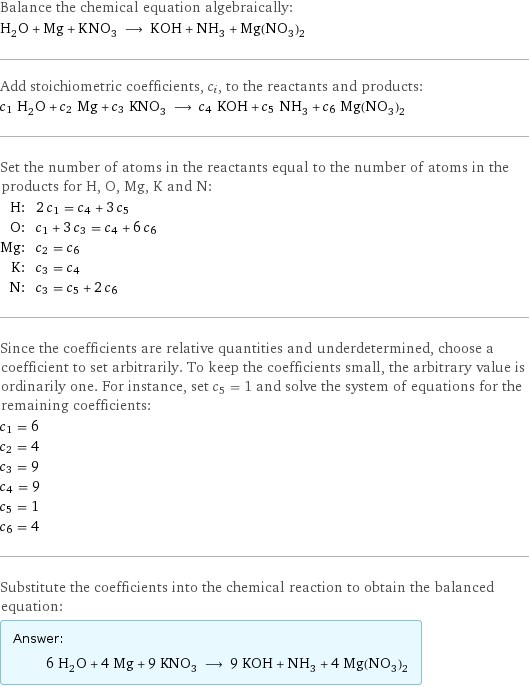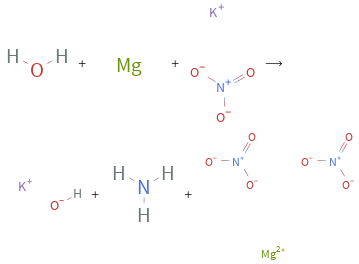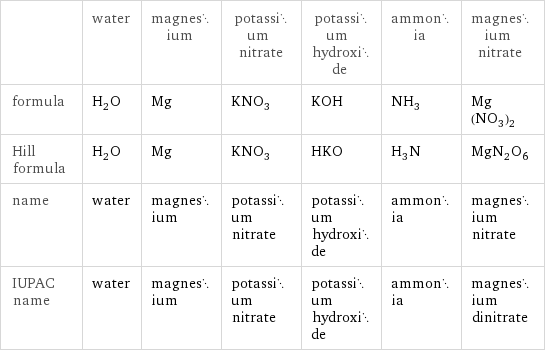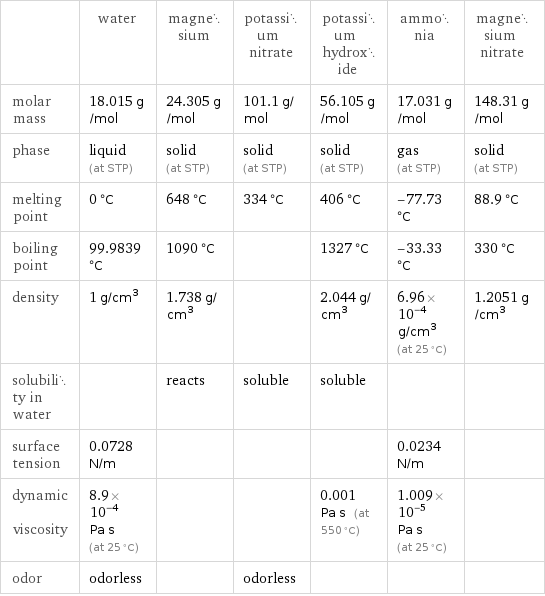Input interpretation

H_2O water + Mg magnesium + KNO_3 potassium nitrate ⟶ KOH potassium hydroxide + NH_3 ammonia + Mg(NO_3)_2 magnesium nitrate
Balanced equation

Balance the chemical equation algebraically: H_2O + Mg + KNO_3 ⟶ KOH + NH_3 + Mg(NO_3)_2 Add stoichiometric coefficients, c_i, to the reactants and products: c_1 H_2O + c_2 Mg + c_3 KNO_3 ⟶ c_4 KOH + c_5 NH_3 + c_6 Mg(NO_3)_2 Set the number of atoms in the reactants equal to the number of atoms in the products for H, O, Mg, K and N: H: | 2 c_1 = c_4 + 3 c_5 O: | c_1 + 3 c_3 = c_4 + 6 c_6 Mg: | c_2 = c_6 K: | c_3 = c_4 N: | c_3 = c_5 + 2 c_6 Since the coefficients are relative quantities and underdetermined, choose a coefficient to set arbitrarily. To keep the coefficients small, the arbitrary value is ordinarily one. For instance, set c_5 = 1 and solve the system of equations for the remaining coefficients: c_1 = 6 c_2 = 4 c_3 = 9 c_4 = 9 c_5 = 1 c_6 = 4 Substitute the coefficients into the chemical reaction to obtain the balanced equation: Answer: | | 6 H_2O + 4 Mg + 9 KNO_3 ⟶ 9 KOH + NH_3 + 4 Mg(NO_3)_2
Structures

+ + ⟶ + +
Names

water + magnesium + potassium nitrate ⟶ potassium hydroxide + ammonia + magnesium nitrate
Reaction thermodynamics
Enthalpy

| water | magnesium | potassium nitrate | potassium hydroxide | ammonia | magnesium nitrate molecular enthalpy | -285.8 kJ/mol | 0 kJ/mol | -494.6 kJ/mol | -424.6 kJ/mol | -45.9 kJ/mol | -790.7 kJ/mol total enthalpy | -1715 kJ/mol | 0 kJ/mol | -4451 kJ/mol | -3821 kJ/mol | -45.9 kJ/mol | -3163 kJ/mol | H_initial = -6166 kJ/mol | | | H_final = -7030 kJ/mol | | ΔH_rxn^0 | -7030 kJ/mol - -6166 kJ/mol = -863.7 kJ/mol (exothermic) | | | | |
Equilibrium constant
![Construct the equilibrium constant, K, expression for: H_2O + Mg + KNO_3 ⟶ KOH + NH_3 + Mg(NO_3)_2 Plan: • Balance the chemical equation. • Determine the stoichiometric numbers. • Assemble the activity expression for each chemical species. • Use the activity expressions to build the equilibrium constant expression. Write the balanced chemical equation: 6 H_2O + 4 Mg + 9 KNO_3 ⟶ 9 KOH + NH_3 + 4 Mg(NO_3)_2 Assign stoichiometric numbers, ν_i, using the stoichiometric coefficients, c_i, from the balanced chemical equation in the following manner: ν_i = -c_i for reactants and ν_i = c_i for products: chemical species | c_i | ν_i H_2O | 6 | -6 Mg | 4 | -4 KNO_3 | 9 | -9 KOH | 9 | 9 NH_3 | 1 | 1 Mg(NO_3)_2 | 4 | 4 Assemble the activity expressions accounting for the state of matter and ν_i: chemical species | c_i | ν_i | activity expression H_2O | 6 | -6 | ([H2O])^(-6) Mg | 4 | -4 | ([Mg])^(-4) KNO_3 | 9 | -9 | ([KNO3])^(-9) KOH | 9 | 9 | ([KOH])^9 NH_3 | 1 | 1 | [NH3] Mg(NO_3)_2 | 4 | 4 | ([Mg(NO3)2])^4 The equilibrium constant symbol in the concentration basis is: K_c Mulitply the activity expressions to arrive at the K_c expression: Answer: | | K_c = ([H2O])^(-6) ([Mg])^(-4) ([KNO3])^(-9) ([KOH])^9 [NH3] ([Mg(NO3)2])^4 = (([KOH])^9 [NH3] ([Mg(NO3)2])^4)/(([H2O])^6 ([Mg])^4 ([KNO3])^9)](../image_source/a599a864270e11e7947819d5ab1a3105.png)
Construct the equilibrium constant, K, expression for: H_2O + Mg + KNO_3 ⟶ KOH + NH_3 + Mg(NO_3)_2 Plan: • Balance the chemical equation. • Determine the stoichiometric numbers. • Assemble the activity expression for each chemical species. • Use the activity expressions to build the equilibrium constant expression. Write the balanced chemical equation: 6 H_2O + 4 Mg + 9 KNO_3 ⟶ 9 KOH + NH_3 + 4 Mg(NO_3)_2 Assign stoichiometric numbers, ν_i, using the stoichiometric coefficients, c_i, from the balanced chemical equation in the following manner: ν_i = -c_i for reactants and ν_i = c_i for products: chemical species | c_i | ν_i H_2O | 6 | -6 Mg | 4 | -4 KNO_3 | 9 | -9 KOH | 9 | 9 NH_3 | 1 | 1 Mg(NO_3)_2 | 4 | 4 Assemble the activity expressions accounting for the state of matter and ν_i: chemical species | c_i | ν_i | activity expression H_2O | 6 | -6 | ([H2O])^(-6) Mg | 4 | -4 | ([Mg])^(-4) KNO_3 | 9 | -9 | ([KNO3])^(-9) KOH | 9 | 9 | ([KOH])^9 NH_3 | 1 | 1 | [NH3] Mg(NO_3)_2 | 4 | 4 | ([Mg(NO3)2])^4 The equilibrium constant symbol in the concentration basis is: K_c Mulitply the activity expressions to arrive at the K_c expression: Answer: | | K_c = ([H2O])^(-6) ([Mg])^(-4) ([KNO3])^(-9) ([KOH])^9 [NH3] ([Mg(NO3)2])^4 = (([KOH])^9 [NH3] ([Mg(NO3)2])^4)/(([H2O])^6 ([Mg])^4 ([KNO3])^9)
Rate of reaction
![Construct the rate of reaction expression for: H_2O + Mg + KNO_3 ⟶ KOH + NH_3 + Mg(NO_3)_2 Plan: • Balance the chemical equation. • Determine the stoichiometric numbers. • Assemble the rate term for each chemical species. • Write the rate of reaction expression. Write the balanced chemical equation: 6 H_2O + 4 Mg + 9 KNO_3 ⟶ 9 KOH + NH_3 + 4 Mg(NO_3)_2 Assign stoichiometric numbers, ν_i, using the stoichiometric coefficients, c_i, from the balanced chemical equation in the following manner: ν_i = -c_i for reactants and ν_i = c_i for products: chemical species | c_i | ν_i H_2O | 6 | -6 Mg | 4 | -4 KNO_3 | 9 | -9 KOH | 9 | 9 NH_3 | 1 | 1 Mg(NO_3)_2 | 4 | 4 The rate term for each chemical species, B_i, is 1/ν_i(Δ[B_i])/(Δt) where [B_i] is the amount concentration and t is time: chemical species | c_i | ν_i | rate term H_2O | 6 | -6 | -1/6 (Δ[H2O])/(Δt) Mg | 4 | -4 | -1/4 (Δ[Mg])/(Δt) KNO_3 | 9 | -9 | -1/9 (Δ[KNO3])/(Δt) KOH | 9 | 9 | 1/9 (Δ[KOH])/(Δt) NH_3 | 1 | 1 | (Δ[NH3])/(Δt) Mg(NO_3)_2 | 4 | 4 | 1/4 (Δ[Mg(NO3)2])/(Δt) (for infinitesimal rate of change, replace Δ with d) Set the rate terms equal to each other to arrive at the rate expression: Answer: | | rate = -1/6 (Δ[H2O])/(Δt) = -1/4 (Δ[Mg])/(Δt) = -1/9 (Δ[KNO3])/(Δt) = 1/9 (Δ[KOH])/(Δt) = (Δ[NH3])/(Δt) = 1/4 (Δ[Mg(NO3)2])/(Δt) (assuming constant volume and no accumulation of intermediates or side products)](../image_source/99d6aa7cc143d7947666ef0a45d345ad.png)
Construct the rate of reaction expression for: H_2O + Mg + KNO_3 ⟶ KOH + NH_3 + Mg(NO_3)_2 Plan: • Balance the chemical equation. • Determine the stoichiometric numbers. • Assemble the rate term for each chemical species. • Write the rate of reaction expression. Write the balanced chemical equation: 6 H_2O + 4 Mg + 9 KNO_3 ⟶ 9 KOH + NH_3 + 4 Mg(NO_3)_2 Assign stoichiometric numbers, ν_i, using the stoichiometric coefficients, c_i, from the balanced chemical equation in the following manner: ν_i = -c_i for reactants and ν_i = c_i for products: chemical species | c_i | ν_i H_2O | 6 | -6 Mg | 4 | -4 KNO_3 | 9 | -9 KOH | 9 | 9 NH_3 | 1 | 1 Mg(NO_3)_2 | 4 | 4 The rate term for each chemical species, B_i, is 1/ν_i(Δ[B_i])/(Δt) where [B_i] is the amount concentration and t is time: chemical species | c_i | ν_i | rate term H_2O | 6 | -6 | -1/6 (Δ[H2O])/(Δt) Mg | 4 | -4 | -1/4 (Δ[Mg])/(Δt) KNO_3 | 9 | -9 | -1/9 (Δ[KNO3])/(Δt) KOH | 9 | 9 | 1/9 (Δ[KOH])/(Δt) NH_3 | 1 | 1 | (Δ[NH3])/(Δt) Mg(NO_3)_2 | 4 | 4 | 1/4 (Δ[Mg(NO3)2])/(Δt) (for infinitesimal rate of change, replace Δ with d) Set the rate terms equal to each other to arrive at the rate expression: Answer: | | rate = -1/6 (Δ[H2O])/(Δt) = -1/4 (Δ[Mg])/(Δt) = -1/9 (Δ[KNO3])/(Δt) = 1/9 (Δ[KOH])/(Δt) = (Δ[NH3])/(Δt) = 1/4 (Δ[Mg(NO3)2])/(Δt) (assuming constant volume and no accumulation of intermediates or side products)
Chemical names and formulas

| water | magnesium | potassium nitrate | potassium hydroxide | ammonia | magnesium nitrate formula | H_2O | Mg | KNO_3 | KOH | NH_3 | Mg(NO_3)_2 Hill formula | H_2O | Mg | KNO_3 | HKO | H_3N | MgN_2O_6 name | water | magnesium | potassium nitrate | potassium hydroxide | ammonia | magnesium nitrate IUPAC name | water | magnesium | potassium nitrate | potassium hydroxide | ammonia | magnesium dinitrate
Substance properties

| water | magnesium | potassium nitrate | potassium hydroxide | ammonia | magnesium nitrate molar mass | 18.015 g/mol | 24.305 g/mol | 101.1 g/mol | 56.105 g/mol | 17.031 g/mol | 148.31 g/mol phase | liquid (at STP) | solid (at STP) | solid (at STP) | solid (at STP) | gas (at STP) | solid (at STP) melting point | 0 °C | 648 °C | 334 °C | 406 °C | -77.73 °C | 88.9 °C boiling point | 99.9839 °C | 1090 °C | | 1327 °C | -33.33 °C | 330 °C density | 1 g/cm^3 | 1.738 g/cm^3 | | 2.044 g/cm^3 | 6.96×10^-4 g/cm^3 (at 25 °C) | 1.2051 g/cm^3 solubility in water | | reacts | soluble | soluble | | surface tension | 0.0728 N/m | | | | 0.0234 N/m | dynamic viscosity | 8.9×10^-4 Pa s (at 25 °C) | | | 0.001 Pa s (at 550 °C) | 1.009×10^-5 Pa s (at 25 °C) | odor | odorless | | odorless | | |
Units
